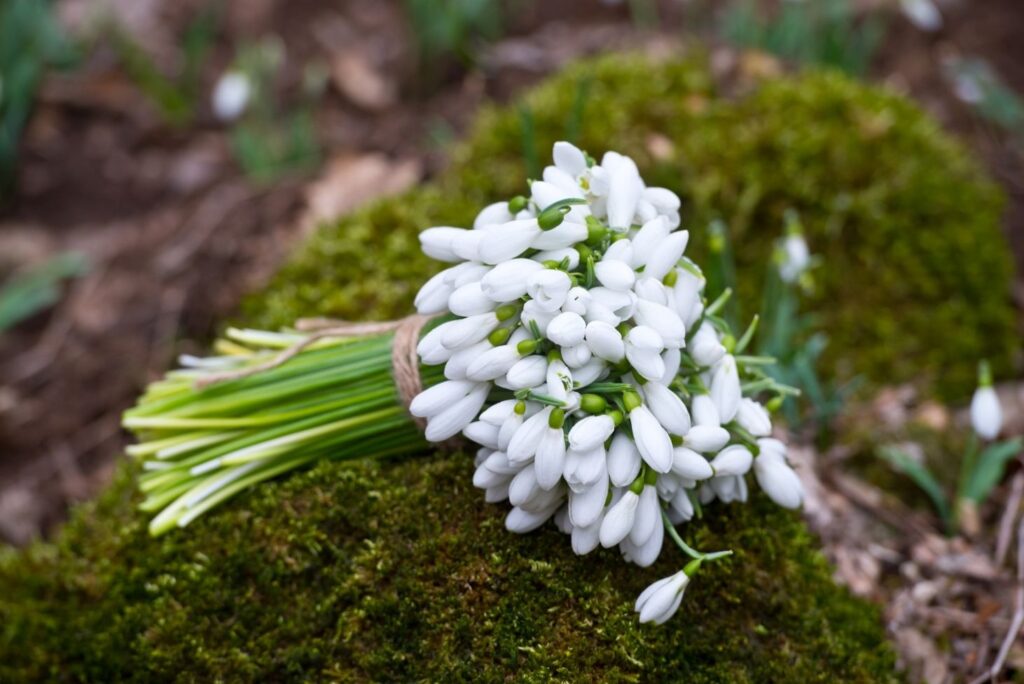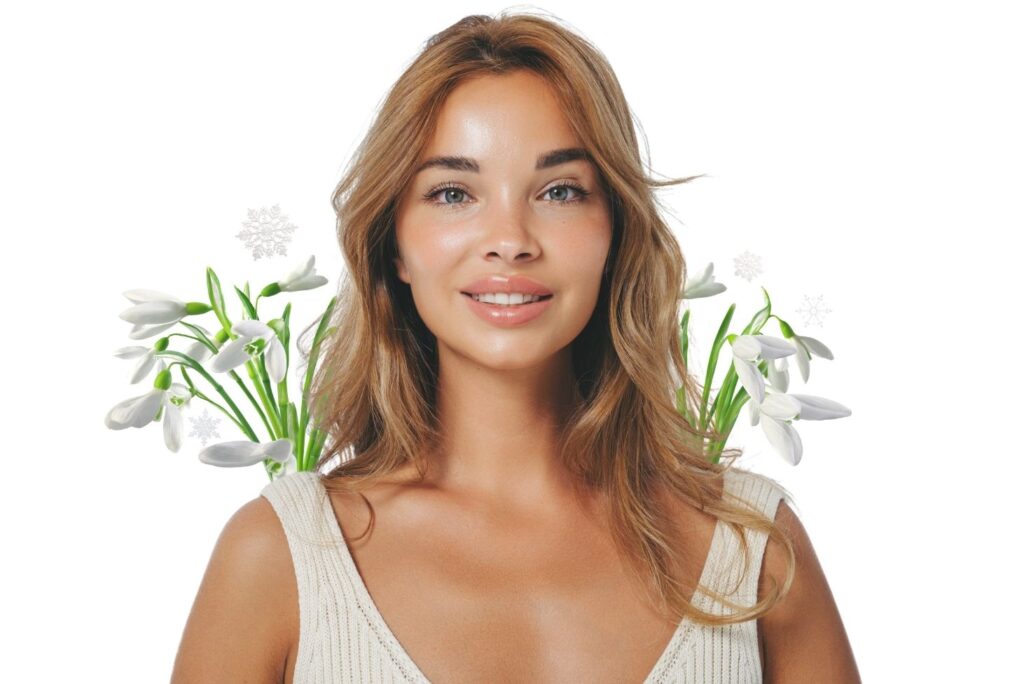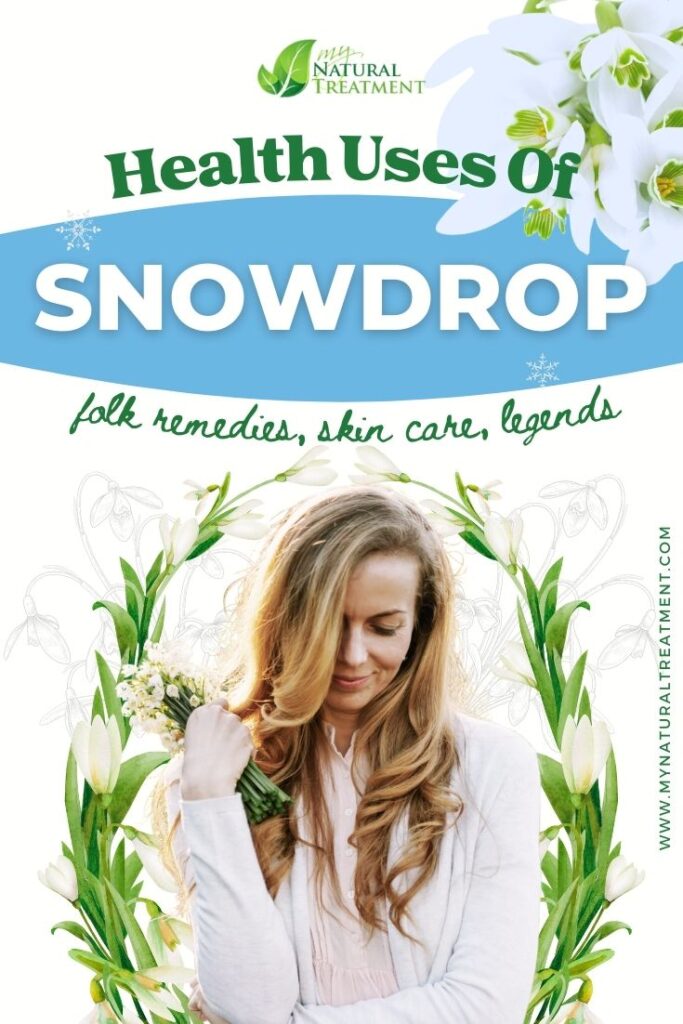Want to learn more about snowdrop uses in medicine, natural skincare recipes with snowdrops, and how to make snowdrop tincture? Continue reading this article and find out.
Snowdrops (Galanthus nivalis) are the first flowers that come out from the snow at the beginning of the year and announce the end of winter and the beginning of spring. Their gentle white hoods resemble angel bells in children’s stories, making them impossible to be confused. Their fresh, cool scent, is reminiscent of the snow that has melted away giving new life. But what are the snowdrop uses beyond their pure beauty? Let’s find out.

In This Article You Will Find:
Are Snowdrops Medicinal?
Beautiful and very gentle flowers, snowdrops have also been used in folk medicine for ages. Traditionally, snowdrops have been used by people in central, eastern, and southern Europe in soothing rheumatic pains, for relieving headaches and treating paralysis caused by polio. They have also used this magical flower in whitening the skin tone against aging spots and freckles as natural skincare.
What Is Snowdrop Used For
The main medicinal use for snowdrops is concentrated in their bulbs, but the whole plant contains these active principles. These active ingredients are galantamine, tazetine, lectin, and lycorine. These alkaloids have antiviral, antimicrobial, cytotoxic, anticonvulsant, antitumor, hypotensive, and anti-inflammatory activity. Galantamine and lycorine are the most studied alkaloids in snowdrop used as treatments in neurological diseases, namely in:
- hemiplegia (paralysis of half of the body, left or right)
- hemiparesis (significant reduction in voluntary body movements)
- polio sequelae
- Alzheimer’s
- thromboembolic diseases
Other potential medicinal uses of snowdrops are:
- reverse transcriptase inhibitor
- anticancer treatment
- antitumoral, antiviral, antifungal
- natural insecticide
Galantamine was extracted from snowdrops in the mid-50s after a Bulgarian pharmacologist saw remote villagers rubbing their forehead with the plant leaves and bulbs to soothe headaches. The effect of galantamine on Alzheimer’s disease is being tested in major clinics around the world, due to its potential inhibiting action of acetylcholinesterase. Acetylcholinesterase is an enzyme with the function of inactivating acetylcholine, one of the most important neurotransmitters.

2 Natural Remedies with Snowdrops
1. Rheumatic Pains
One of the most popular folk snowdrops uses is for rheumatic pains. For this, you can add snowdrop flowers (but only dried), to your bath water to relieve rheumatic pain. Internally, you can make snowdrop bulb tea, and enjoy 2-3 cups of tea daily. Since snowdrop bulbs can be toxic, it is good to buy them dried from a natural pharmacy. In addition, you can friction the painful areas with snowdrop tincture.
How to Make Snowdrop Tincture
To make the snowdrop tincture, pour 350 ml (12 oz) of homemade fruit alcohol over 16 whole snowdrop flowers. Seal and allow the flowers to soak in the alcohol for 1-2 weeks. Strain and keep the snowdrop tincture in an amber bottle in a cool place. The snowdrop tincture can be used externally, to friction painful areas affected by rheumatism, the temples when you have a headache, or pain of neurological cause.
2. Facial Paralysis
One old home remedy for facial paralysis with snowdrops uses the entire snowdrop plant (flower, leaves, bulb). Finely chop the whole dried plant and boil 1 tsp in 1 cup of water for a couple of minutes. Remove from the heat and infuse for 10 minutes. The recommended dose is 1 cup of this tea a day. This is one of the old folk snowdrop uses.

3 Natural Skincare Recipe with Snowdrop
1. Snowdrop Juice for Brown Spots
One of the most popular snowdrop uses is for brown spots on the skin. Squeeze the juice from snowdrop bulbs and leaves and apply it to the face by dabbing on the affected areas, 3-4 times a day. This simple natural skincare is especially used to reduce brown spots on the face.
2. Skin Whitening Lotion
There are two ways to prepare this natural skin whitening lotion with snowdrops. The first one is this. Bring 1 cup of water to boil and when it starts boiling add 2 heaped tablespoons of dried snowdrop flowers (approx. 50 g). Take away from the heat, cover, and infuse for one hour. Strain, pour in an amber bottle and the skin whitening lotion with snowdrops is ready. Pad your skin with a cotton swab, in the morning and evening. Store in the fridge for no more than 3 days.
The second way to make this skin whitening lotion at home is to fill up a small mason jar with dried and crushed snowdrops, and then pour apple cider vinegar over them just to cover. Seal tightly and allow the lotion to soak for two days (shake several times a day). Strain and mix with an equal amount of distilled water. Lotion your skin in the morning and in the evening, especially the skin spots. Keep in the fridge and use within a week. This is one of the most effective snowdrop uses.
3. Snowdrops for Freckles
Put two handfuls of fresh snowdrop flowers in a mason jar and pour fresh lemon juice over them just enough to cover the flowers. Give it a good stir, seal, and leave soak for three days. Strain using gauze, and store the skin lotion in dark amber bottles. Rub the freckles with this lotion in the evening, before bed. Repeat until the freckles fade away completely. Be aware that the root cause behind freckles can be related to liver toxicity, pregnancy, use of contraceptives or antibiotics, age, congenital predispositions, etc.
Read Also: 5 Natural Skin Care Recipes with Spring Flowers
Is Snowdrop Poisonous?
The snowdrop bulbs can be toxic when consumed in large quantities, due to their high content of lycorine, an alkaloid that may be highly poisonous, or even lethal when ingested in certain quantities. The snowdrop bulbs are not recommended for consumption.
The use of herb preparations is not recommended without seeking advice from your physician or pharmacist. The substances they contain may interact with the subscribed drugs that the patient already takes, thus eliminating their therapeutic efficacy or inducing toxicity.
The Romanian Legend of The Snowdrop
According to an old Romanian fairy tale, once upon a time, the sun was embodied as a young loving girl that showed up every year to warm up and bring light to the world. One year, the monster of winter seized the girl and imprisoned her in his castle. Therefore the world remained without the warmth of the summer sun.
A young man defied the monster of winter and defeated him in battle. He succeeded in freeing the young girl but he was seriously injured in the battle. Legend has it that his blood drops fell in the white snow melting it away and were transformed into the gentle snowdrop flowers. The snowdrop is a symbol of the coming of spring, a time of death and rebirth at the same time.
Read About The Health Uses of Other Spring Flowers:
Corydalis
Cowslip
Daffodil
Daisy
Lily of the Valley
Sweet Violet
If you’ve enjoyed learning about the snowdrop uses, its medicinal properties, and the natural skincare with snowdrops, please share this article so more people can read it. Hope you’re having a magical springtime!
Share on Pinterest ❤️


